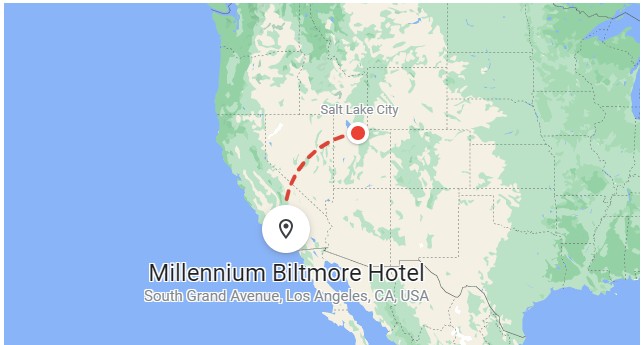
In the past, when visiting Los Angeles, we have stayed around Hollywood somewhere. You can see the 2012 photo album by clicking on the pictures below (in Hollywood). If you are contemplating visiting, you may be interested to read about out unfortunate experience 2017 here...
This time we rejected Hollywood in favour of downtown LA. The Millennium Biltmore. It's central and a lot nicer than the places we've stayed over there.
 The Millenium Biltmore Hotel and the nearby Public Library
The Millenium Biltmore Hotel and the nearby Public Library
- lower right - a most impressive building
During the afternoon I spent an hour or so in the Public Library, waiting for Wendy to return from her grand shopping expedition to the outlets. I also took a walk up the street (hill) to the local Art Museums: The Museum of Contemporary Art (MoCA) and the BROAD. I would visit the BROAD another day.
To see some of the artworks at MoCA and BROAD click on the pictures below.
I subsequently discovered that they can be reached, without climbing the hill, by staying on the lower streets. These lead around to the local produce market and the Angels Flight Funicular. You know: 'Funiculi Funicular'. It costs $1 to be taken up. But it's a longer walk.
There is also a bus service, for less than a dollar, but it's infrequent or you can take the Metro to the markets (one stop).
 Chess players near the Mall metro station; The gallery/concert precinct; Angels Flight Funicular; In the metro station;
Chess players near the Mall metro station; The gallery/concert precinct; Angels Flight Funicular; In the metro station;
In the Walt Disney Concert Hall foyer; Local architecture of interest (Art Deco etc)
To see some of my photos of the art in MoCA and the BROAD click on the image above (top-right).
The BROAD is adjacent to the architecturally spectacular Walt Disney Concert Hall. It's more impressive outside than in the foyer (see above) but I understand that the auditorium itself is equally marvellous.
 Walt Disney Concert Hall, LA. Architect: Frank Gehry
Walt Disney Concert Hall, LA. Architect: Frank Gehry
